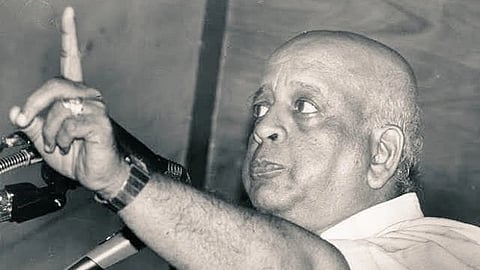
- Home
- NG Hindi
- India
- World
- Politics
- Sex & Relationships
- Entertainment
- Culture
- Lifestyle
- Economy
- Sports
- Sp. Coverage
- Misc.
- NewsGram Exclusive
- Jobs / Internships

T.N. Seshan enforced strict reforms to end corruption, booth capturing, and misuse of power during elections.
He empowered the Election Commission and made the Model Code of Conduct a serious ethical standard.
Seshan’s fearless leadership created lasting trust in India’s electoral system, earning him national admiration
When politicians believed they ruled elections, T.N. Seshan stepped in and reminded them that it was the Constitution of India that truly ruled — and he was its iron hand.
Tirunellai Narayana Iyer Seshan (1932–2019), one of India’s most iconic bureaucrats, served as the 10th Chief Election Commissioner (CEC) from 1990 to 1996. He transformed the Election Commission of India from a quiet, passive office into one of the most powerful and respected institutions in the country.
Before his tenure, Indian elections were infamous for booth capturing, bribery, money and muscle power, and open violations of the Model Code of Conduct. Seshan’s fearless reforms and strict discipline changed that image forever.
During his tenure, T.N. Seshan introduced several groundbreaking reforms that redefined how elections were conducted in India.
He strictly enforced the Model Code of Conduct, made voter ID cards mandatory, set spending limits for candidates, and appointed polling officials from outside the states where elections were being held. He banned bribery, liquor distribution, and the misuse of government machinery for campaigning. Seshan also prohibited political appeals based on caste or religion and banned the use of places of worship for political purposes.
His reforms brought visible results. Booth capturing in Uttar Pradesh dropped from 873 cases in 1991 to just 255 in 1993, and polling-day killings fell from 36 to only 3.
In 1994, he demanded the removal of two Union Ministers — Sitaram Kesari and Kalpnath Rai — for trying to influence voters. During the 1996 general elections, he deployed 1,500 election observers (three for each constituency) and mobilized over 1.5 million state employees along with 600,000 security personnel to ensure fair polling.
His no-nonsense approach earned him immense public admiration, even as many politicians found him too strict. To the people, he became a hero — the man who stood up to corruption and restored faith in Indian democracy.
A 1955-batch IAS officer from the Tamil Nadu cadre, Seshan served as India’s 18th Cabinet Secretary in 1989 before becoming CEC. Known for his discipline and efficiency, he often said:
In 1996, he received the Ramon Magsaysay Award for Government Service for his courageous and reformist leadership. He later contested the Presidential election in 1997 and even ran for the Lok Sabha on a Congress ticket in 1999.
When Seshan took charge of the Election Commission in December 1990, he made his authority clear from the start. Within minutes of assuming office, he addressed the staff and declared that the Commission would uphold the dignity of Indian democracy. He brought discipline, strengthened the system of election observers, and insisted on deploying central police forces to ensure peaceful polling.
Under his leadership, the Model Code of Conduct — once seen as a mere formality — became a serious and enforceable standard. He even approached the Supreme Court to defend the Election Commission’s right to act against officers who failed in their duties.
When the government tried to reduce his powers by appointing two additional Election Commissioners in 1993, Seshan famously said, “If they clip my wings, I will run like an ostrich.” His fearless attitude made him both respected and feared across political circles.
Seshan’s impact on Indian democracy was so deep that people often say there were two eras of the Election Commission — before Seshan and after Seshan. He made citizens believe again that free and fair elections were possible and reminded the nation that the true power of democracy lies with the voters, not politicians. As he once said:
T.N. Seshan passed away on November 10, 2019, at the age of 86, in Chennai. Tributes poured in from across the country for the man who transformed Indian elections. The Election Commission of India described him as “the man who redefined the grammar of Indian elections.”
Even today, every time India votes peacefully and freely, the spirit of T.N. Seshan lives on — reminding us that democracy thrives only when elections remain fair, fearless, and for the people.
When did T.N. Seshan took charge as the Chief Election Commissioner of India?
T.N. Seshan took charge as the Chief Election Commissioner of India on December 12, 1990.
What was the cause of T.N. Seshan’s death?
T.N. Seshan died of cardiac arrest on November 10, 2019, in Chennai, at the age of 86.
[Rh]
Suggested Reading:
